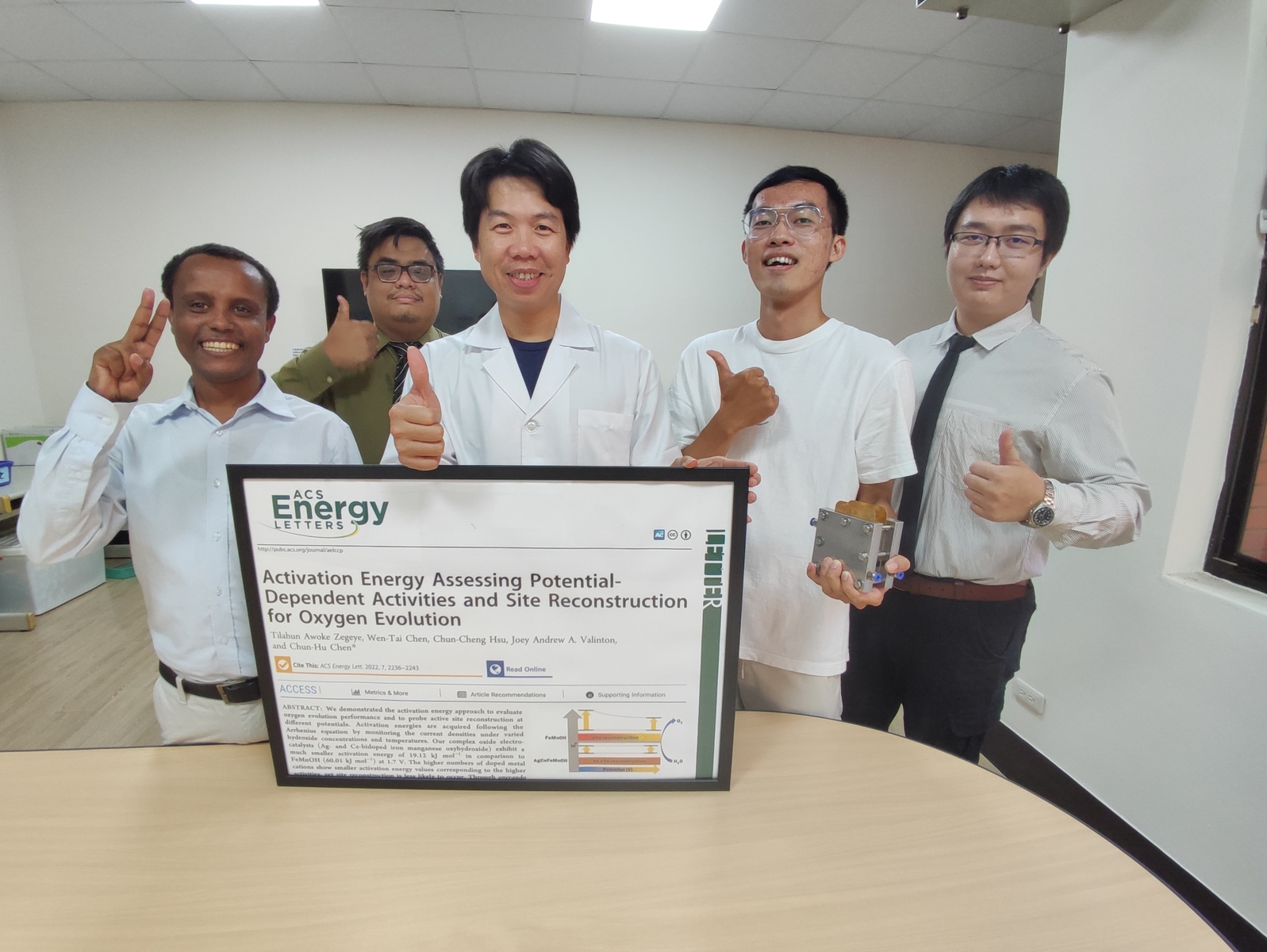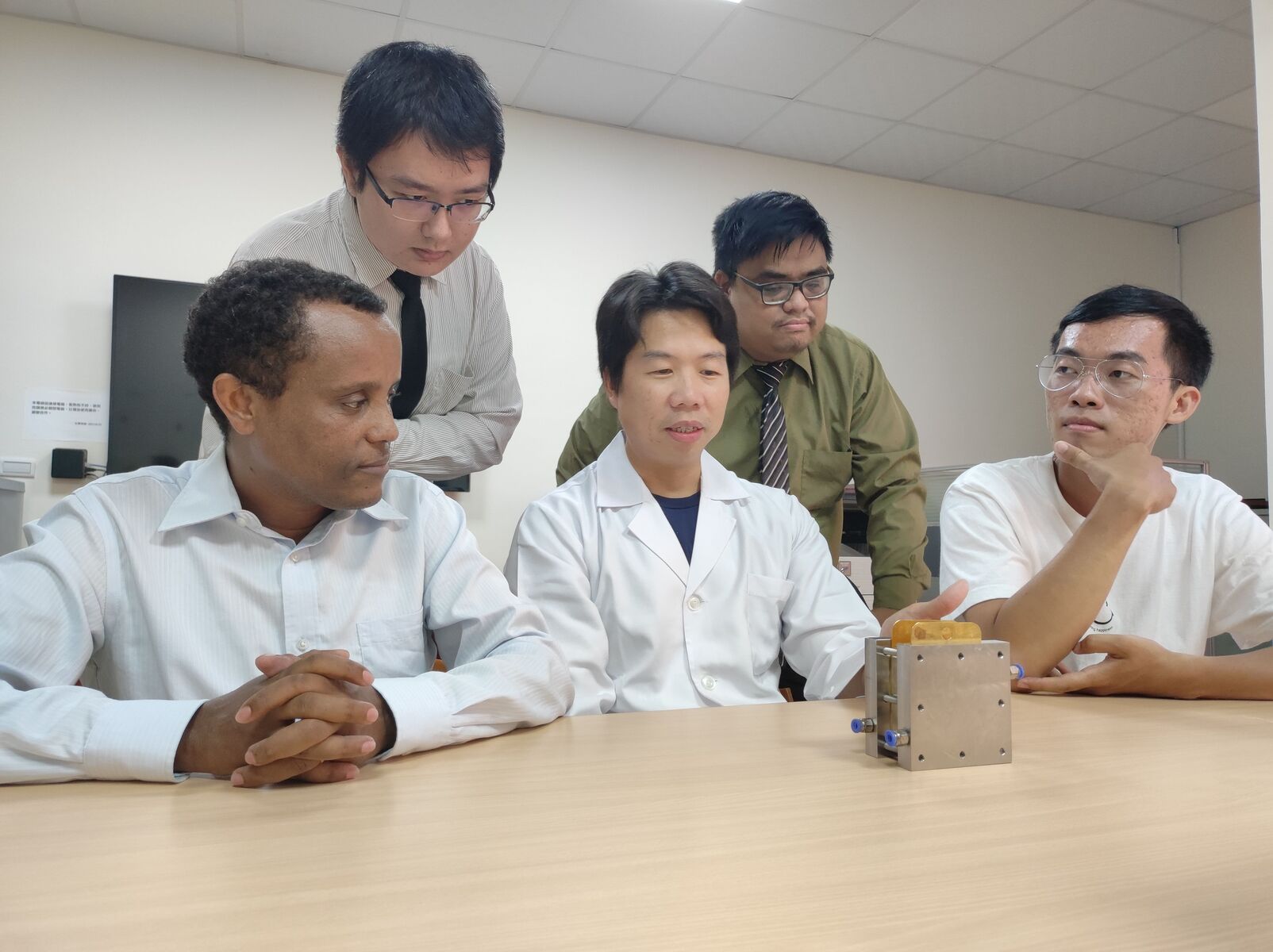NSYSU’s Pioneering Green Hydrogen Production Tech Reduces Cost by 1/1000


The record-breaking high temperatures this summer, as well as the war between Russia and Ukraine has intensified the dilemma between the energy needs of Europe such as natural gas, and the economy and livelihood of those peoples. To reduce the usage of fossil fuels. and mitigate climate change and other environmental problems, developing clean and renewable energy sources are needed. Green hydrogen, made from splitting water through the electricity coming from greener sources of energy such as solar or wind, becomes a powerful tool to reduce carbon emissions, and store energy.
The research group Chun-Hu Chen, a professor at the Department of Chemistry of National Sun Yat-sen University developed the novel “acidic redox-assisted deposition” technology to create a new generation of complex oxide electrocatalysts. The catalysts produced are 4.6 times more active than the commonly used nickel catalysts and can perform better than precious ruthenium-based catalysts. The method mainly uses iron and manganese, which greatly reduces the cost to 1/1000. The results of this research has been published in the ACS Energy Letters, one of the top international journals.
Professor Chen emphasized that the results also show that the synthesized catalyst can also do seawater splitting with high stability and excellent corrosion resistance. “We recently took seawater from Sizihwan Bay convert it into hydrogen for the long term, which made me realize that we have the entire bay to be converted into a sea of hydrogen in the future! Unchaining ourselves out of importation-dependent energy will also avoid regional conflicts that can disrupt the energy supply,” he said.
The research team highlights the need of hydrogen as a raw material for today’s industry, such as raw materials for the production of ammonia, hydrogen peroxide and methanol, rocket fuel, and a reducing agent for metal extraction. Compared with other sources of renewable energy, hydrogen can effectively store green energy. Therefore, the electrolysis of water to generate hydrogen can be utilized as a renewable energy storage solution. However, green hydrogen only accounts for less than 0.1% of global hydrogen production capacity according to the International Energy Agency (IEA) report. This is mainly due to the high production cost, reaching USD 3 to 7.5 per kilogram. Hence, there are still many barriers to be overcome leading to the use of green hydrogen as a major industrial raw material and fuel source.
"Precious metal catalysts such as platinum, ruthenium, and iridium currently used in water electrolysis are too expensive, destabilizing the opportunity for large-scale use of hydrogen," said Prof. Chen. To further reduce the production cost of hydrogen and reach the practical stage of people's livelihood, the research team has long developed catalysts with earth-abundant metals (such as iron, cobalt, nickel, etc.) to replace precious metals with affordable ones, thereby promoting widespread use of hydrogen energy. In this case, iron and manganese are used to develop catalysts that only cost at most 1/1000 than those made out of precious metals. In addition, compared with the commonly used nickel catalyst, the new catalyst developed by the team has 4.6 times higher activity and better power conversion efficiency, which means less power consumption is required to produce the same amount of hydrogen, reducing the cost of electricity.
The team members involved in the study included Dr. Tilahun Awoke Zegeye, and graduate students Wen-Tai Chen, Chun-Cheng Hsu, and Joey Andrew Valinton. This technology has been supported by the Ministry of Science and Technology, Taiwan, National Sun Yat-sen University, as well as industry partners for a total funding of more than NTD 10 million in research and development. At present, a series of industry-academia cooperation has been carried out with well-known enterprises and academic research units in Taiwan. In the future, the technology will move towards higher energy conversion efficiency that can reduce electricity costs and make the energy used by humans more environmentally friendly, thereby bringing mitigation to climate change.
The research group Chun-Hu Chen, a professor at the Department of Chemistry of National Sun Yat-sen University developed the novel “acidic redox-assisted deposition” technology to create a new generation of complex oxide electrocatalysts. The catalysts produced are 4.6 times more active than the commonly used nickel catalysts and can perform better than precious ruthenium-based catalysts. The method mainly uses iron and manganese, which greatly reduces the cost to 1/1000. The results of this research has been published in the ACS Energy Letters, one of the top international journals.
Professor Chen emphasized that the results also show that the synthesized catalyst can also do seawater splitting with high stability and excellent corrosion resistance. “We recently took seawater from Sizihwan Bay convert it into hydrogen for the long term, which made me realize that we have the entire bay to be converted into a sea of hydrogen in the future! Unchaining ourselves out of importation-dependent energy will also avoid regional conflicts that can disrupt the energy supply,” he said.
The research team highlights the need of hydrogen as a raw material for today’s industry, such as raw materials for the production of ammonia, hydrogen peroxide and methanol, rocket fuel, and a reducing agent for metal extraction. Compared with other sources of renewable energy, hydrogen can effectively store green energy. Therefore, the electrolysis of water to generate hydrogen can be utilized as a renewable energy storage solution. However, green hydrogen only accounts for less than 0.1% of global hydrogen production capacity according to the International Energy Agency (IEA) report. This is mainly due to the high production cost, reaching USD 3 to 7.5 per kilogram. Hence, there are still many barriers to be overcome leading to the use of green hydrogen as a major industrial raw material and fuel source.
"Precious metal catalysts such as platinum, ruthenium, and iridium currently used in water electrolysis are too expensive, destabilizing the opportunity for large-scale use of hydrogen," said Prof. Chen. To further reduce the production cost of hydrogen and reach the practical stage of people's livelihood, the research team has long developed catalysts with earth-abundant metals (such as iron, cobalt, nickel, etc.) to replace precious metals with affordable ones, thereby promoting widespread use of hydrogen energy. In this case, iron and manganese are used to develop catalysts that only cost at most 1/1000 than those made out of precious metals. In addition, compared with the commonly used nickel catalyst, the new catalyst developed by the team has 4.6 times higher activity and better power conversion efficiency, which means less power consumption is required to produce the same amount of hydrogen, reducing the cost of electricity.
The team members involved in the study included Dr. Tilahun Awoke Zegeye, and graduate students Wen-Tai Chen, Chun-Cheng Hsu, and Joey Andrew Valinton. This technology has been supported by the Ministry of Science and Technology, Taiwan, National Sun Yat-sen University, as well as industry partners for a total funding of more than NTD 10 million in research and development. At present, a series of industry-academia cooperation has been carried out with well-known enterprises and academic research units in Taiwan. In the future, the technology will move towards higher energy conversion efficiency that can reduce electricity costs and make the energy used by humans more environmentally friendly, thereby bringing mitigation to climate change.
Click Num:
Share
